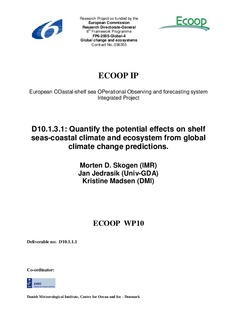| dc.contributor.author | Skogen, Morten D. | |
| dc.date.accessioned | 2010-11-24T09:56:16Z | |
| dc.date.available | 2010-11-24T09:56:16Z | |
| dc.date.issued | 2010-02-03 | |
| dc.identifier.uri | http://hdl.handle.net/11250/109519 | |
| dc.description | ECOOP WP10, Deliverable no: D10.1.3.1 | en_US |
| dc.description.abstract | Knowledge of how hydrography, circulation and production on the lower trophic levels will change due to climate change, is crucial for our understanding and management of the ecosystem in the future. Three different models have been used to predict the effect of climate change in the North Sea and Baltic (one model in both areas, and the two others in one area each)
Despite different set-up and focus and two very different approaches for the predictions, the models agree on the level of change in ocean temperature. The IMR model also shows that North Sea transports and primary production is most sensitive to changes in wind forcing. | en_US |
| dc.language.iso | eng | en_US |
| dc.publisher | Danish Meteorological Institute | en_US |
| dc.subject | hydrography | en_US |
| dc.subject | hydrografi | en_US |
| dc.subject | trophic interactions | en_US |
| dc.subject | trofiske interaksjoner | en_US |
| dc.subject | ecosystem models | en_US |
| dc.subject | økosystemmodeller | en_US |
| dc.title | Quantify the potential effects on shelf seas-coatal physics/climate and ecosystems from global climate change predictions | en_US |
| dc.type | Research report | en_US |
| dc.subject.nsi | VDP::Mathematics and natural science: 400::Zoology and botany: 480::Ecology: 488 | en_US |
| dc.subject.nsi | VDP::Mathematics and natural science: 400::Geosciences: 450::Hydrology: 454 | en_US |
| dc.subject.nsi | VDP::Mathematics and natural science: 400::Geosciences: 450::Oceanography: 452 | en_US |
| dc.source.pagenumber | 18 s. | en_US |
